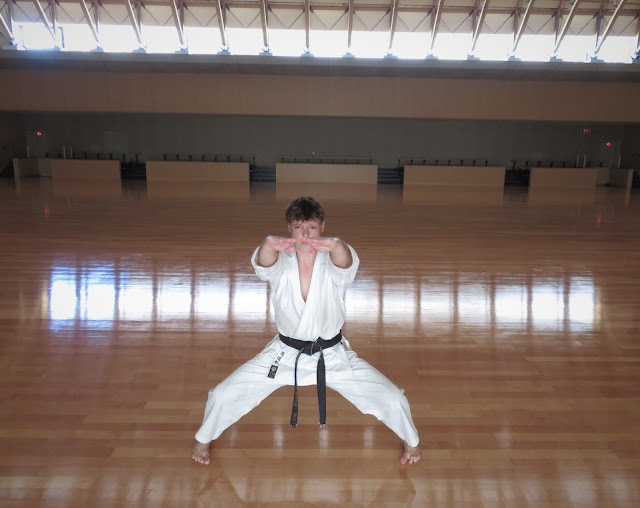The 足の小指 or
small toes are essential in karate, regarding the route of 1’s
ft. After all, I might checklist all of the 立ち方
(tachikata)/stances of karate; nonetheless, by merely utilizing the three important
‘prolonged stances’ in kihon apply—騎馬立ち(kiba-dachi),
前屈立ち(zenkutsu-dachi) and 後屈立ち (kokutsu-dachi)—this
side will probably be greater than clear. I’ll additionally make clear another associated factors in
this text, however I’ll tackle these later.
Permit me to clarify why the 小指
(small toes) are so essential in karate…
Firstly and clearly, they’re weakest
toes of the ft.
Secondly, as stated above, the route they’re pointing is
what actually establishes the route of your ft (as a common rule, please word this, on my kokutsu-dachi level, which I am going to state on the finish of this text). Firstly consider
kiba-dachi. In case your ‘pinkies’ are completely pointing straight forward, there’s
truly a slight inversion of each ft. This is identical with the pillar
(rear) leg of kokutsu-dachi. That’s, the small toe is ideally 90 levels so
that, like in kiba-dachi, there will probably be a slight inversion of the foot in direction of
the entrance. As said earlier than, I’ll depart the lead leg of kokutsu-dachi for now, and that may grow to be apparent why later.
Taking a look at zenkutsu-dachi the entrance foot is, after all
barely inverted. Once more, this place is dictated by the koyubi. That’s, by
simply pointing the foot generically ahead is inadequate. Quite, it’s the small
toe pointing ahead; thus, ensuing within the inversion of your complete foot.
Certainly, we should additionally have a look at the rear foot in zenkutsu-dachi as nicely. Once more,
ideally talking, the rear foot is lower than, and no higher than, 45 levels to the
entrance; furthermore and as soon as once more, the main target right here ought to once more be on the koyubi.
Thirdly, why is all this the case? Effectively, as said this half
of the foot is the weakest, subsequently, we should use it in concord with the
stronger toes: the strongest, after all, being the large toe.
Moreover, there
is one other essential level: 足刀
(sokuto). In Shotokan, a crucial fundamental in kihongeiko is “conserving your complete foot as flat on
the ground as doable”. The primary focus, on this regard, is conserving ‘sokoto
down’ versus the widespread error of ‘rolling them over’, which ends up in
instability of the respective leg in query.
This rule is just in classical coaching, however, when
strictly adhered to, when partaking in freestyle, it makes one’s pure motion
a lot simpler. On this regard, optimum is the very best phrase. Put one other manner,
standing in a pure jiyu dachi, it’s like ‘taking the breaks off’ (when
transferring with agility and reactively is the precedence). Along with this, it permits one “…to
retain and recuperate steadiness when executing
full pace and full energy strategies in opposition to an opponent”, or some other
bodily goal (sandbag, focus mitts,
and so on. Discover one thing right here??
What I’m elucidating right here is “…that when ‘throwing
strategies into the air’ (I.e. – solo kihon and kata) we hold the ft flat”;
that’s, sokuto down. Now, please at all times take into account that this intrinsically
pertains to the 小指 (koyubi). The one exception to that is the
classical Yakusoku-Kumite: 五本組手
(Gohon Kumite), 基本一本組手
(Kihon Ippon Kumite), and essentially the most fundamental type of 自由一本組手
(Jiyu Ippon Kumite). To place this in context, these strategies of Kumite should be
acknowledged for what they are surely: ‘Accomplice Kihon Drills’ which “…prepare the
classical strategies of karate—with one other individual/opponent—and progressively
bridge the hole nearer in direction of Jiyu Kumite: while mitigating the lack of kime
in strategies”.
So, we are able to see that sokuto isn’t just for kicking…
Furthermore, the significance of the 小指
(small toes) for exact foot instructions, which not solely end in stunning
foot positions in stances however optimize the ft for explosive pace and energy;
steadiness and restoration; and generically talking, wonderful tuned bodily management.
OK, so when you intently learn above, you’ll discover that I
purposefully not noted the lead leg of kokutsu-dachi. Effectively, I did that on goal
as it’s what I personally time period as ‘a rule breaker’, which is a continuing in karate and all
types of budo for that matter. On this case, your complete foot factors ahead as
against the small toe. It is because the prime focus is on the compression
of the rear leg and the entrance foot establishes one’s line for energy transition
versus being immediately for perform itself. This additionally allows a impartial
place for a kizami-geri; nonetheless, this considerably deviates from the focal
factors of this text.
To conclude, by correctly understanding, and making use of of your
koyubi, you possibly can readily obtain skilled classical stances with Japanese taste;
moreover, these classical positions and the ensuing unsoku/footwork from them, will drastically improve
one’s Jiyu Kumite and skill to defend oneself.
© André Bertel. Oita Metropolis, Japan (2022).






